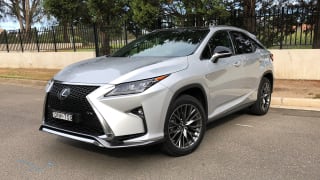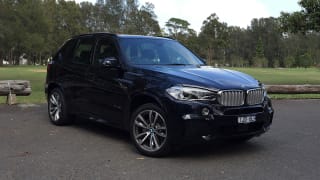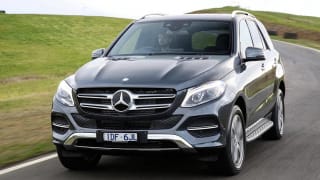There are three Q7s in our model comparison, excluding the V8-powered triple-turbo SQ7. The range starts with the 160 at $97,800, with the 160 designation referring to the engine output in kilowatts.
The 160 starts the range with 19-inch alloys wheels, dual-zone climate control air-conditioning, reverse camera, front and rear parking sensors, bi-xenon headlights, LED daytime running lights, Wi-Fi hotspot, keyless entry and push button start via smart key, electric power steering, cruise control, hill-descent control, quattro all-wheel drive, power tailgate, floor mats, chrome exhaust tips, electric front seats, leather trim, air-quality sensor, park assist, electric everything, auto wipers and headlights and a comprehensive safety package.
Read More: Audi Q7 e-tron 2018 review: snapshot
Read More: Audi Q7 3.0 TDI 160 2018 review: snapshot
Read More: Audi Q7 3.0 TDI 200 2018 review: snapshot
Rather than supplying a spare tyre, Audi gives you a tyre-repair kit.
Stepping up to the 200, the price increases to $106,900, with an attendant increase in horsepower. The basic specification is roughly the same between the two versions, with detail differences.
The 200 adds four-zone climate control, a self-parking system, full body paint finish (body colour applied to the lower extremities of the car) and Audi's excellent 'Virtual Cockpit' digital dashboard.

The difference between the 160 and the 200 is small but useful. The diesel fuel economy is barely different, you get the same transmission, 4x4 system and overall comfort.
Both 160 and 200 buyers have a wide choice of colours: 'Night Black' and 'Carrara White' are free. 'Orca Black', 'Galaxy Blue', 'Ink Blue', 'Cobra Beige' (more gold, really), 'Argus Brown', 'Graphite Grey', 'Temperament Red' and 'Florett Silver' are all $2250. 'Sepang Blue' and 'Daytona Grey' are $7050.
The e-tron adds the hybrid electric unit, loses the third row of seating and some cargo capacity and comes with a full suite of safety systems, heated front seats, 'Audi Connect', LED headlights, e-tron styling and adaptive air suspension. The options list is way shorter, however, but few e-trons find their way into customers' hands.
Audi e-tron buyers are down to seven colours: Night Black, Carrara White, Orca Black, Ink Blue, Graphite Grey and Florett Silver are all freebies.

The many iPhone users out there will be very pleased that Apple CarPlay is standard on the Q7, while Android Auto is also available. As always, Audi's MMI mutlimedia system is excellent. The big 8.3-inch screen is run by a console-mounted rotary dial and touchpad, but it's not yet a touch screen.
GPS sat nav is available across the range. The navigation system can also have a Google Earth overlay. Obviously there is a mobile-phone bluetooth connection in addition to the USB. The multimedia gadgets include a CD player, DVD player, MP3 functionality and the usual AM/FM radio as well as DAB.
As it's an Audi, there's a huge options list as well as various packages to add to the lengthy standard features list.
The $6200 'Technik' technology pack adds the excellent head-up display, plus nine speakers to the stereo (19 in total, including sub-woofer) and wireless phone charging.
The Assistance package includes additions to the safety list (see below).

Of course, the drive-away price can be significantly affected by options choice. The standard price list is just the start, and the amount you can choose to spend on options is breathtaking.
You can upgrade the sound system to a thumping Bang & Olufsen with 23 speakers (including sub-woofer) for a whopping $13,990 (it's a good one), a panoramic sunroof for $3990, four-wheel steering for $2650, air suspension ($4690), 'Matrix LED' headlights ($4850), rear seat entertainment system, side steps, - you get the idea. If I have this right, you can almost double the cost of the Q7 with options.
The S-Line options are more an exterior design pack than the dynamic pack they used to be, offering ever-bigger alloy wheels, side skirts, darker tinted windows, subtle front spoiler and LED headlights.
Ceramic brakes with red brake calipers aren't available in 'standard' Q7s but are available on the sport edition SQ7.
Unavailable are autopilot self driving, tool kit, nudge bar, bull bar, auxiliary heater, heated steering wheel, sunglass holder, carbon fiber trim, 'Homelink', specific premium package and cargo liner.




















